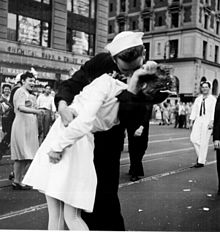
V-J Day in Times Square
by Sarah Urbank
Imagine city streets crowded with people cheering, dancing, and embracing. Music fills the air as streamers made from rags and toilet paper fall from high-rise windows to land in ankle-deep piles on streets on the streets below. This was the hectic scene in Times Square, New York City, on August 14, 1945, otherwise known as Victory over Japan Day, or V-J Day. Alfred Eisenstaedt, a photojournalist, was photographing the chaos in Times Square that evening when he happened upon a sailor who kissed a nurse in the middle of the square. Eisenstaedt took four shots, and the resultant, iconic picture, “V-J Day in Times Square,” appeared on page 27 of LIFE magazine on August 27, 1945, taking up an entire page with the soon-legendary photograph (Ronk). It was a time for celebration, a moment tha twould be remembered for years to come, and the origin of an iconic photo of dubious beginnings that has come to symbolize joy and love.

Editor’s Note: This is the public domain version of Eisenstaedt’s famous image. See Works Cited list below for direct link to Eisenstaedt’s image.
The early 1940s is not usually attributed as a time for celebration and excess. World War II, which ended in 1945, was a long war that devastated a large portion of the globe. Although the United States of America was not a battleground, emotional turmoil spread throughout the country as Americans felt the fear, loss, and pain of war. The country rationed itself to provide for the war effort, and many people lost friends and family in the conflict. Americans everywhere waited hopefully for the end. It was in this anxious atmosphere that over 200,000 people crowded into New York City’s Times Square on the afternoon of August 14, 1945, to watch the news bulletins in hope of hearing of the end of the war in Japan (Carlson). After the announcement was made, the crowd rejoiced, and an anonymous pair tht had been working for the war effort smacked lips in time for Eisendstaedt’s legendary picture. Audiences everywhere have since seen the photograph as an interpretation of American culture during the 1940s, and the civilian reaction to the second World War’s end.
Upon first glance, the photograph has a simple focus. The young male sailor with his dark uniform stands out at a sharp contrast to the woman he is holding, a female nurse in a white frock, tights, and heels. Their uniforms are the norm for a sailor and nurse in the 1940s, and the bystanders’ dress also draws tribute tot he era. Although there are people in the background, the picture focuses on the nurse and sailor. Concentrating on the pair hints at a greater story behind their embrace. By showing how anonymous war contributors celebrate their victory, “the photograph celebrates not merely the end of war, but the common people who won it” (Hariman). For this moment and this photo, the victory is abut the sailor and the nurse.
The photograph may be seen as representative of culture in the 1940s in its context and subject matter, but what it does not contain speaks even more. The main focus of the image is two young and presumably heterosexual Caucasian-Americans that have obviously been involved in the war effort. The picture shows one side of the war, a pretty, romanticized, gleeful celebration of joy and hope. It does not show the struggles of war or the contributions of those who were not white or wearing uniforms. The image focuses upon a very specific demographic, with “relations of class…masked by focusing on individuals” with qualities such as race “effaced, as the world worth saving appears to be a white world” (Carlson). Each person clearly depicted in the foreground has white skin and large smiles pasted happily upon their faces. Whether or not the image is purposely staged this way, it sends a message that white America is the focal point of the war effort and celebration, hiding all others. Additionally, the black and white symbolism of this picture is not limited to race.
The stereotypical picture of 1940s culture includes idealized concepts of gender and sexuality. The photograph relies heavily upon contrast to draw attention to different elements of the scene, including gender. In comparison, the stark contrast between black and white, or man and woman, is a highlight of the image. The man appears in a shady black sailor’s uniform that highlights the nurse’s pure white dress. He comes from above her to kiss her and holds her in place as he stands firmly on his feet. The nurse, however, is unsteady in her white heels as the sailor bends her back. The image of a man holding a woman in place in an uncomfortable position promotes the idea of male dominance and reflects a society in which “women are acted upon, rather than acting” (Carlson). The nurse’s reaction is hidden, leaving only the sailor’s possessive hold on her and the bystanders’ cheerful expressions, which set the mood of the scene. This generates an atmosphere of happiness and joy where there may not be one.
The genuine context of this kiss is highly debated. The true identities of the pair have never been confirmed, although LIFE magazine reportedly received multiple claims from alleged sailors and nurses over the years that believed they were part of the famous duo (Goldstein). Eisenstaedt himself could never confirm the identities of the two and, therefore, the true story behind the kiss is unknown. Therefore, the photograph is left to interpretation, where they could be anything from a happy anonymous couple to an aggressor and a victim of sexual assault. Regardless of speculation, their identities have been lost to time.
Eisenstaedt’s photograph hides as much as it reveals. It depicts the height of supposed normalcy in 1945’s American climate: an enthusiastic young white heterosexual couple, both changed by the war and both euphoric to see its end. However, the exact focus of the picture excludes the diversity of America and reinforces the gender morals of the 1940s. Without context, it is difficult to interpret the exact story behind the photograph, but the years have given it connotations of love and triumph. While “V-J Day in Times Square” is not strictly representative of America, it is still a significant image intended to celebrate the end of a tragic and terrible war.
Works Cited
Carlson, Peter. “The Happiest Day in American History.” American History 45.3 (2010): 50-57. Academic Search Complete. Web. 10 Oct. 2012.
Eisenstaedt, Alfred. “V-J Day in Times Square.” Digital Image. TIME.com. LIFE, 13 Aug. 2012. Web. 10 Oct. 2012. <http://life.time.com/world-war-ii/v-j-day-1945-a-nation-lets-loose/#1>
Goldstein, Richard. “Edith Shain, Who Said Famous Kiss Came Her Way, Dies at 91.” NYTimes.com. The New York Times, 24 June 2010. Web. 10 Oct. 2012.
Hariman, Robert, and John Louis Lucaites. “The Times Square Kiss: Iconic Photography and Civic Renewal in U.S. Public Culture.” Journal of American History 94.1 (2007): 122-131. Academic Search Complete. Web. 10 Oct. 2012.
Ronk, Liz. “Life.” TIME.com. LIFE, 13 Aug. 2012. Web. 9 Oct. 2012. <http://life.time.com/world-war-ii/v-j-day-1945-a-nation-lets-loose/>